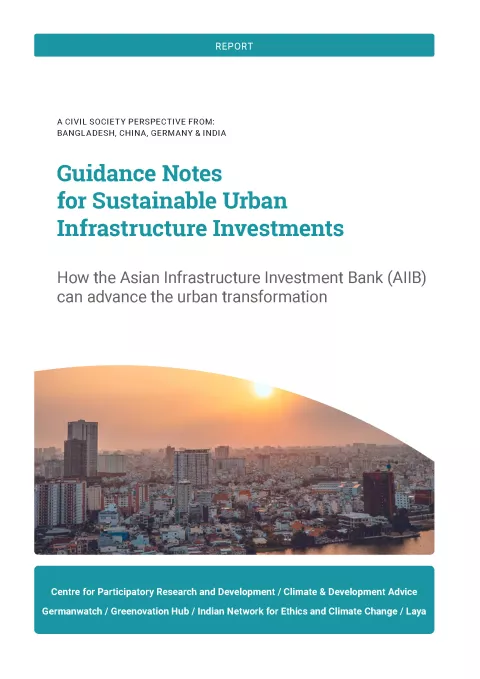
As the decade of implementation gets underway, public development banks need to follow up on their goals and statements of intent with action. The world's fastest growing development bank, the Asian Infrastructure Investment Bank (AIIB), plays a critical role in infrastructure investment in Asia, where the bulk of future urban development will take place. The challenges of the mega-trends of urbanization and climate change must be met with consideration for particularly vulnerable populations. To this end, this report provides a method of analysis based on seven principles to strengthen urban transformation in a sustainable and inclusive way.
Urbanisation is a global megatrend that will bring immense challenges in the coming decades, especially in Asia and Africa. Achieving the goals of sustainable development, limiting global warming and preserving ecosystems and biodiversity will depend to a large extent on whether we succeed in making the expansion and reconstruction of urban infrastructure sustainable.
In view of the chronic underfunding of infrastructure in most developing countries and emerging economies and a continuing strong growth in investment needs to bring about the transformation of cities towards poverty eradication, sustainability, greenhouse gas neutrality and climate resilience, development banks have a special role to play. Due to their particularly good knowledge of the capital markets in developing countries, as well as with their favourable loans, venture capital and guarantees, development banks can reduce the investment risks of classic private investors and thus develop a leverage effect that corresponds to many times the amount of their own investments.
To ensure that infrastructure investments support the transformation of cities towards sustainable development pathways, the authors propose seven principles and 31 subordinate criteria. To operationalise them, they developed a sustainability traffic light system and applied it to the urban sector strategy, the urban project portfolio, the corporate strategy, the business plan 2021 and the financial risk management of the Asian Infrastructure Development Bank (AIIB). AIIB was chosen due to the development of tomorrow's infrastructure being at the heart of its mandate. Furthermore, it is led by China, and abides by the motto of “Lean, Clean & Green”. The same approach could be applied to other infrastructure investors and investees.
This report is intended as a contribution, making suggestions on how to guide investments in the urban transformation towards curbing emissions, enhancing resilience, protecting biodiversity and achieving the Sustainable Development Goals (SDGs). The toolset that we present is preceded by an introductory section that summarises the most important urban challenges and transformative imperatives for action. This is complemented by project examples that highlight different facets of the development of a sustainability-promoting infrastructure. All project examples were submitted in response to an international call for proposals and were selected by the editors. They are illustrative and do not necessarily reflect the views of the editors.
The publication concludes with ten recommendations for the AIIB on how it could support urban transformation and become a sustainability and climate bank by using our sustainability criteria: urban net-zero principle, urban climate resilience principle, urban efficient land-use and spatial planning principle, urban nature-positive principle, circular economy and zero-waste principle, socially inclusive and resilient city principle, and urban pro-poor principle.
The following recommendations, among others, are included: organisation of a stakeholder consultation process for reviewing our approach and suggestions; revision of the urban sector and the corporate strategy in view of the results of our sustainability check, including specific sustainability targets for portfolio development and target achievement indicators; inclusion of a climate – post-pandemic economic recovery in the business plan for 2022; amendment of key risk indicators using metrics to quantify physical climate risks, as well as the stranded asset risk of carbon-intense infrastructure; wider disclosure of project-related documents of public interest; transparent documentation of the implementation of the pledge to fulfil the Bank’s Paris alignment commitment by mid 2023.
This report continues a series of reports already published, including one on the alignment of AIIB with the Paris Agreement and the SDGs (2019) and another on pro-poor and climate resilience principles for infrastructure investment with a special focus on AIIB (2020).





